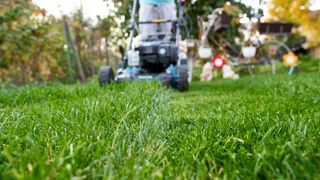In short, mulching in a mower breaks up trimmings to an incredibly fine substance that can be used to bulk out compost or aid grass growth directly. Read on to find out more about this gardening technique, how it is used in a mower, and when is best time to mulch. Don’t forget, some of the best electric lawn mowers (opens in new tab) are also capable of mulching, so if you don’t fancy a gas model, check those green-fingered beauties out too.
What is mulching?
Mulch is essentially any beneficial material spread over the surface of soil. The process of mulching can be done mechanically or manually - and normally involves breaking down natural residue into a product that can be layered over important areas in a garden. Mulching can be done with a variety of different materials. Often manure, tree bark, and dry leaves are used for this end. With mowers, the mulching material produced is in the form of grass clippings, which can be incorporated into compost or as its own layer. Normally, the above materials are composted to increase the nutritional qualities they bestow to plants. Some mulch products, like grass clippings, can just be used as is, and some mowers with mulching functions (for example, the Toro 21378) have options to disperse the fine clippings as they are made.
What is the purpose of mulching?
Mulching is done to achieve several different things. Firstly, mulch massively increases moisture retention within soil. This can help prevent dry earth, and keeps any grass or plants in the vicinity healthy for longer. Trapping in water can be a great boon during the drier months, but this is only one of the many ways mulching can help your garden. It can also insulate the roots of a plant against the dangers of cold weather. The benefit here is obvious, as plants are often in danger of dying in winter months. Mulching can also cut down the amount of tedious weed removal you have to do, as it protects plants from those as well. Finally, mulches provide a hearty nutritional boost to the plants in your garden. Moreover, several mowers (like the Craftsman M105) also include “mulch kits” to improve the quality of the mulch produced. This can even further enhance the nutritional value that the grass clippings give to the soil.
How do you use a mower for mulching?
With a mower, mulching usually occurs due to a blade that spins particularly fast, shredding grass clippings even finer than usual. Sometimes, a separate blade is included in the mower especially for mulching. Many mowers also come with accessory support that includes easy-attach mulch kits, like the Troy-Bilt entry featured in our best riding lawn mowers (opens in new tab) guide. Here are a few good examples of mulch-friendly mowers…
What are the different types of mulching?
There are several ways you can mulch with a mower, and we’ll start with the easiest one. With this method, you let the grass clippings fall wherever the mower leaves them, which should give your garden a mostly even coating that is not too thick. When distributed this way, grass trimmings do not necessarily need to undergo the extra steps of composting. However, it is absolutely essential to make sure these grass clippings are dry. If the grass clippings are wet (this is most common early in the day because of morning dew), they can actually reduce the amount of oxygen that reaches the grass. When this happens, nitrates can form, which often lead to really nasty smells. Another method of mower mulching is a touch more involved, and requires you to collect your clippings. Most mowers come packaged with a removable clippings bag that will work fine for this purpose. If not, it is relatively easy to purchase one online. A clippings bag is certainly worth a buy, as they are up there with the best lawn edgers as the most useful garden care accessories. Once the clippings have been collected, they can be used to bulk out your compost pile, making for more efficient composted mulch.
Do all mowers mulch the ground?
No, but the best ones often do. Mulching is an addition that a lot of higher end lawnmowers include as standard. Even within the group of lawnmowers that mulch, some do it in different ways, coming with the extra mulching blades mentioned already. If you want to get a mower that does mulch, look for ones that explicitly mention it or have “three-in-one” features advertised. When a mower says “three-in-one”, it normally refers to the ways in which it disposes with trimmings. That’s either blown out of the side, deposited into a trimmings bag or mulched.
When is the right time to do mulching?
According to guidance (opens in new tab) from the UK’s Royal Horticultural Society, the perfect time to mulch your garden is mid-late spring, and then again in August. Middle to late spring is the optimal time for mulching as a lot of plants are still dormant, giving the nutrients time to take effect. Further to that, the weeds that mulch typically protects against have not had time to germinate at this point in the year. That makes the weed protection even more potent. The second time you should be mulching your garden is throughout August. This prepares the garden just before those harsh winter months, ensuring that the plants and grass get proper insulation as they die back. One exception to the rule is with new plants. New plants should be mulched at the time of planting, so that proper flourishing can be ensured. If the advice is good enough for the Queen of England, it should be good enough for your backyard. Looking for more gardening content? We’d also recommend our feature on how to aerate a lawn (opens in new tab), as well as our guide to the best lawn edgers (opens in new tab) for tidier gardens.






